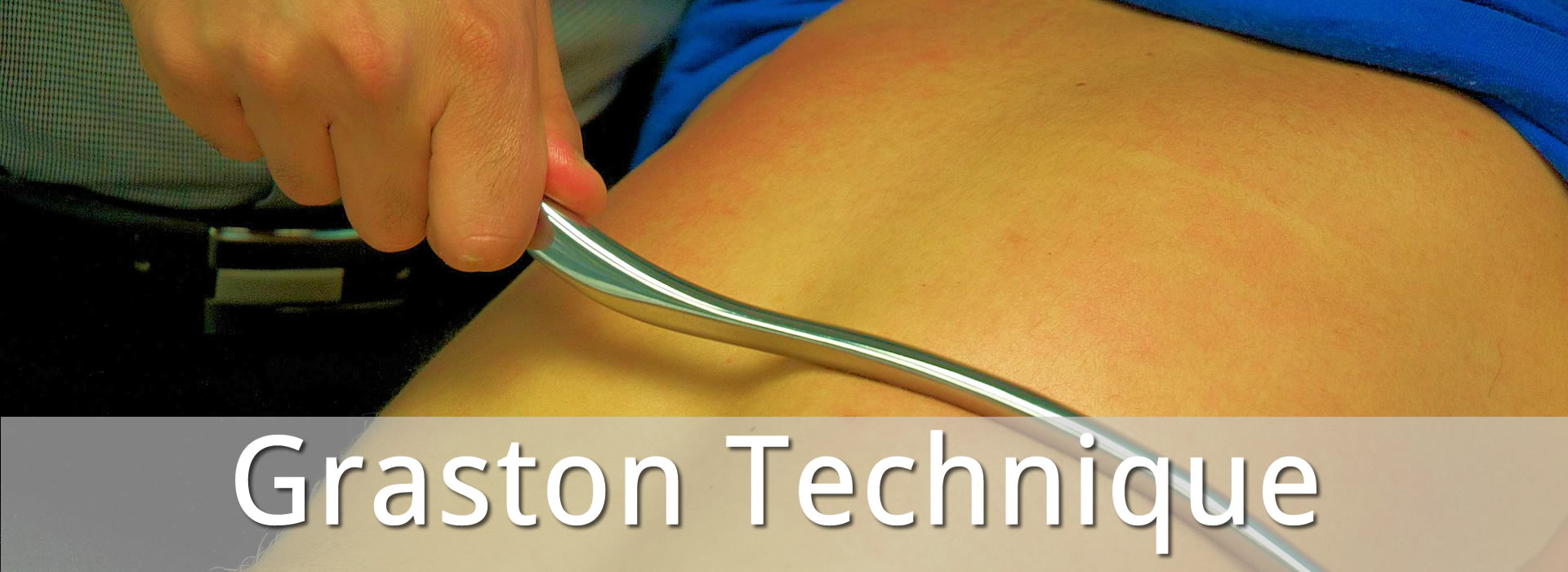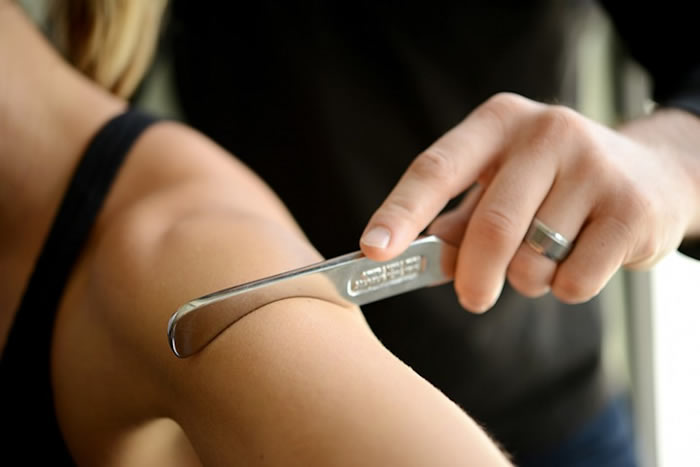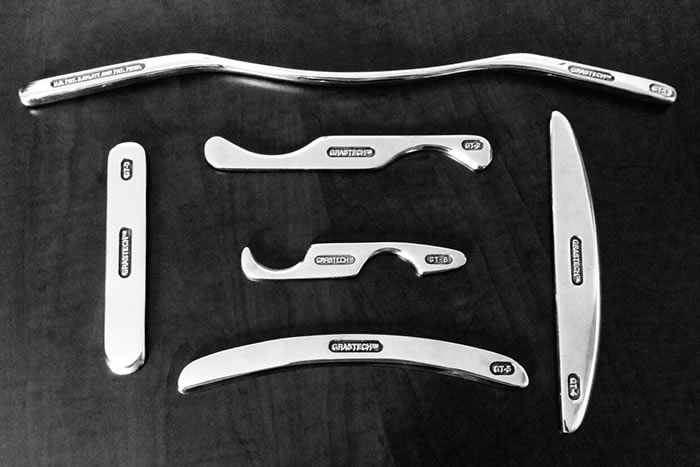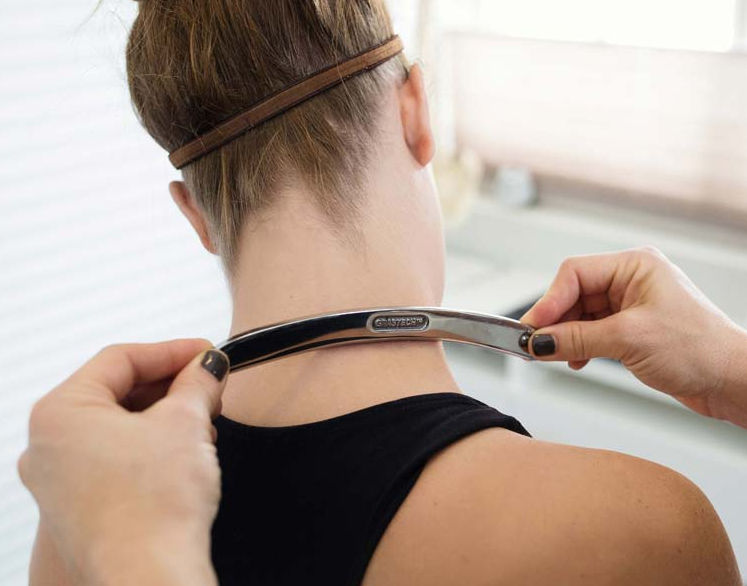

Internal injury and/or repetitive stress to muscle and tissues – perhaps so minor you might not have even realized you were injured – also can result in the formation of scar tissue on the inside as the body works to repair torn or strained tissue. Over time, this fibrous scar tissue can lead to pain and reduced range of motion due to its reduced flexibility and its adhesion to other tissue. Sometimes, internal scar tissue can even painfully constrict or entrap a nerve. A treatment called the Graston Technique, performed at LiveWell Chiropractic and Wellness Center, allows Dr. Ridley to detect and treat areas of scar tissue and adhesions in muscles, tendons, and ligaments.

How is the Graston Technique Performed?
The Graston Technique uses a set of stainless steel instruments that are drawn over the skin of the affected area, and gently “breaks up” the scar tissue or adhesion. Since many injuries produce inflammation, muscle changes and scar tissue, this approach is helpful in creating significant, long-term changes to soft tissues throughout your body.

Dr. Ridley's Instruments
Dr. Ridley’s stainless steel hand instruments allow a deeper, more sensitive detection and treatment of deep restricted tissues. Their concave/convex shapes mold to the various contours of the body for greater comfort and effectiveness. As the instruments are pulled across adhesions and scar tissue, patients often report a temporary tightening, then a pleasant sense of release and wider range of motion.

Repeated visits help Dr. Ridley resolve these areas of scar tissue and improve muscle tone. Most patients have a positive response after one to three treatments. The Graston Technique is a great treatment for carpal tunnel syndrome, plantar fasciitis, and painful knees and shoulders.



Originally developed for the treatment of athletic injuries, the Graston Technique has been very successful in treating both acute and chronic soft tissue injuries. The Graston Technique can be used to help with plantar fascitiis (burning foot pain), sciatica, carpal tunnel, TMJ (temporomandibular joint), knee, elbow and shoulder problems, tight hamstrings or quadriceps — any place in the body with scar tissue and adhesions. Recovery time is faster than with other conventional treatment methods, and there is a reduced need for anti-inflammatory medications. The Graston Technique can resolve even long-standing conditions you may have thought were permanent.
Dr. Ridley advises Graston Technique patients not to be discouraged by initial soreness or bruising at the treatment site. This is a positive sign that the scar tissue has been broken up and restrictions have been released. Soreness is usually minimized after 48 to 72 hours, and can be controlled with ice and stretching. Stretching and strengthening exercises are given to Graston patients to enable them to maintain the release of scar tissue, restrictions, and adhesions. Additionally, Dr. Ridley recommends increased water intake, usually 6 to 8 glasses of water per day, to promote proper healing.
Talk with Dr. Ridley if you or your loved one have been struggling with any of the above conditions at the LiveWell Chiropractic and Wellness Center.
Schedule a consultation with Dr. Ridley at LiveWell Chiropractic and Wellness Center and find out if you are a candidate for treatment with the Graston Technique.

Q: What is the Graston Technique, and how can it help me with scar tissue?
A: The Graston Technique® (GT) is a unique, evidence-based form of instrument-assisted soft tissue mobilization that enables clinicians to effectively and efficiently address soft tissue injury (ligaments, muscles and fascia), scar tissue and fascial restrictions resulting in improved patient outcomes. The Graston Technique uses specially designed stainless steel instruments with unique treatment edges and angles to deliver an effective means of manual therapy. Graston’s goal is to remove scar tissue and fascial restrictions in order to restore pain-free movement and function.
Q: How does the Graston Technique work to reduce scar tissue?
A: The Graston Technique® identifies and treats areas of scar tissue that are hindering the body’s natural range of mobility. When the body is injured, thick bands of scar tissue can form at the site of injury. The treatment technique separates and breaks down the scar tissue across connective tissue and muscle fibers. Dr. Ridley uses specially designed instruments to detect scar tissue locations. Just as a fine comb running through hair will “catch” on a knot or tangle, so too will these instruments “catch” along a piece of scar tissue. Once the scar tissue has been identified, Dr. Ridley will use the instrument to safely break up the tissue so it can be absorbed by the body and fully healed.
Q: Can you help with carpal tunnel syndrome or plantar fasciitis?
A: Yes! Both of these conditions are the result of the build-up of scar tissue and fascial restrictions due repetitive stress or trauma. Often, people that come to us with these conditions will feel a significant improvement in only one or two treatments, and are frequently pain-free after a few more.
Q: Why is scar tissue a problem to begin with?
A: Scar tissue forms after an injury when the body does not correctly heal and the tissue instead heals in a “haphazard” pattern. When examined under a microscope, scar tissue appears different from normal tissue in several ways. Unlike the normal dense, elongated fibers that run in one direction, scar tissue is a collection of irregular, loose fibers running in multiple directions. In addition to causing pain, scar tissue can also hinder mobility. For example, scar tissue can make activities like typing, texting, running, hiking, or throwing a ball more painful, depending on the location of the scar tissue.
Q: Is the Graston Technique treatment painful?
A: The Graston Technique is not designed to be painful or cause excessive bruising. Occasionally, as with any form of manual therapy and depending on the patient's condition, minor discomfort during the procedure and some bruising afterward may be experienced. Dr. Ridley adjusts the intensity of the treatment based on patient feedback to minimize your discomfort.
Q: How many Graston Technique treatments will I need?
A: Depending upon the nature of the injury or maintenance program, patients usually receive one or two treatments per week during the span of four to five weeks. Most patients have a positive response by the third or fourth treatment and many just after one treatment. The average number of Graston Technique sessions per episode of care averages between six and twelve.
Q: What conditions can be treated with the Graston Technique?
A: The Graston Technique effectively and efficiently addresses conditions such as:
Ankle pain (achilles tendinitis or tendinosis)
Wrist pain or carpal tunnel syndrome
Neck pain (cervicothoracic sprain/strain)
Fibromyalgia
Tennis elbow (lateral epicondylitis)
Back pain such as lumbosacral sprains and strains
Golfer’s elbow (medial epicondylitis)
Myofascial pain syndromes
Knee pain (patellofemoral disorders)
Foot pain such as plantar fasciitis
Post-surgical pain such as that from joint replacements and rotator cuff repairs (once post-surgical protocol allows for soft tissue mobilization/manual therapy)
Shoulder pain such as rotator cuff tendinitis
Scar tissue/post-surgical scars (once completely closed)
Patients demonstrating central and/or peripheral sensitization (only used in light stroking/brushing mode to desensitize)
Shin splints
Leg pain, including hamstring and quadriceps tightness
Trigger finger
Women's health/post-mastectomy and caesarean (C-section), breast implant scarring
Graston Technique® can be used to treat any movement system dysfunction that has been determined to have a soft tissue component.

Serving Hurst, Colleyville, North Richland Hills, Euless, Bedford, Ft. Worth, Grapevine, Southlake, Keller, Dallas, Mansfield, Arlington & Watauga.

Office: (817) 485-WELL (9355)
Fax: (817) 427-9355
Email: livewell@LiveWellDFW.com
© Copyright 2017 LiveWell Chiropractic Health & Wellness Center & Dr. Jennifer Ridley. All Rights Reserved. Website Consulting and Strategy by DRKM Strategies - Web Design by Longman Computers